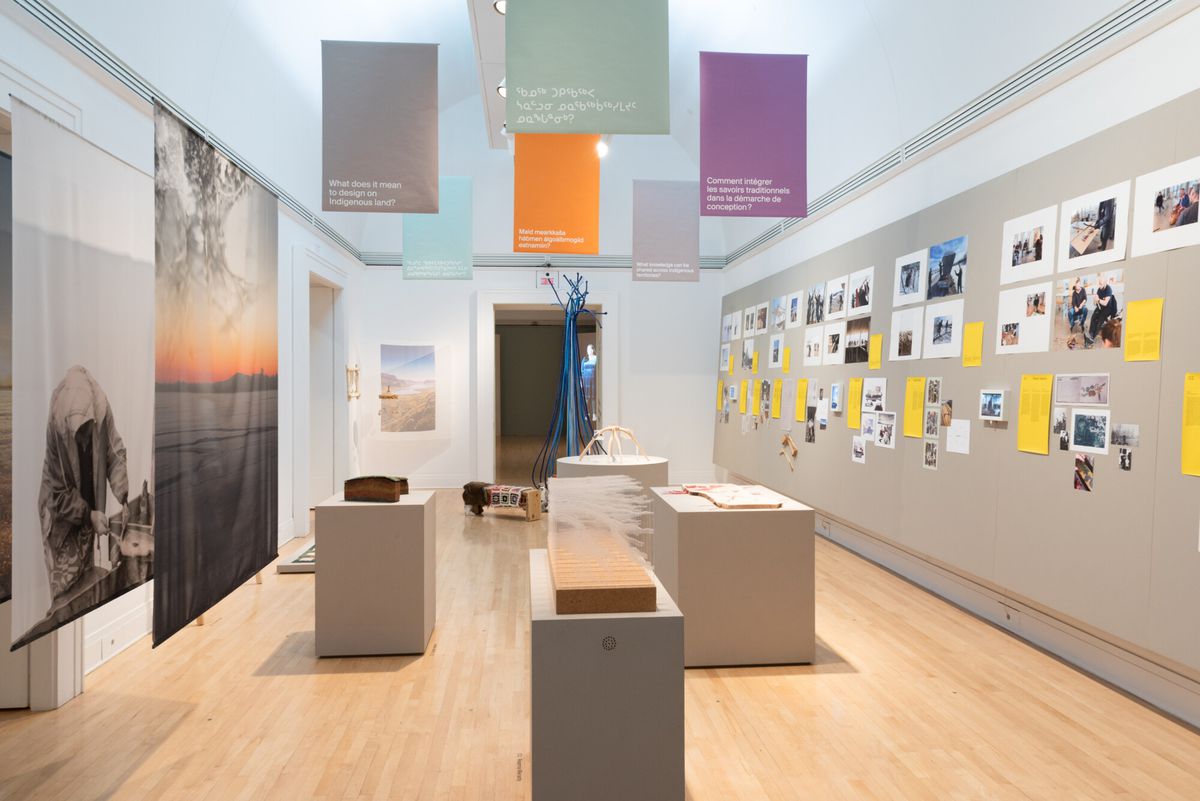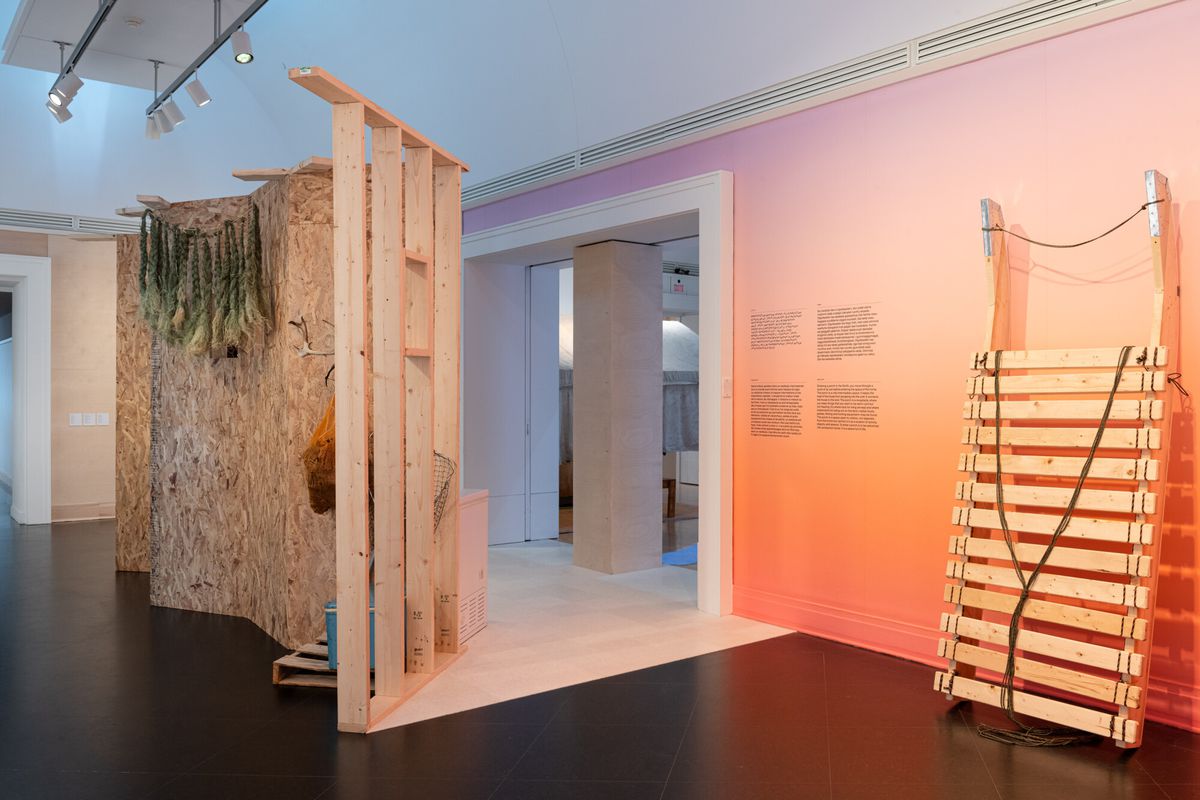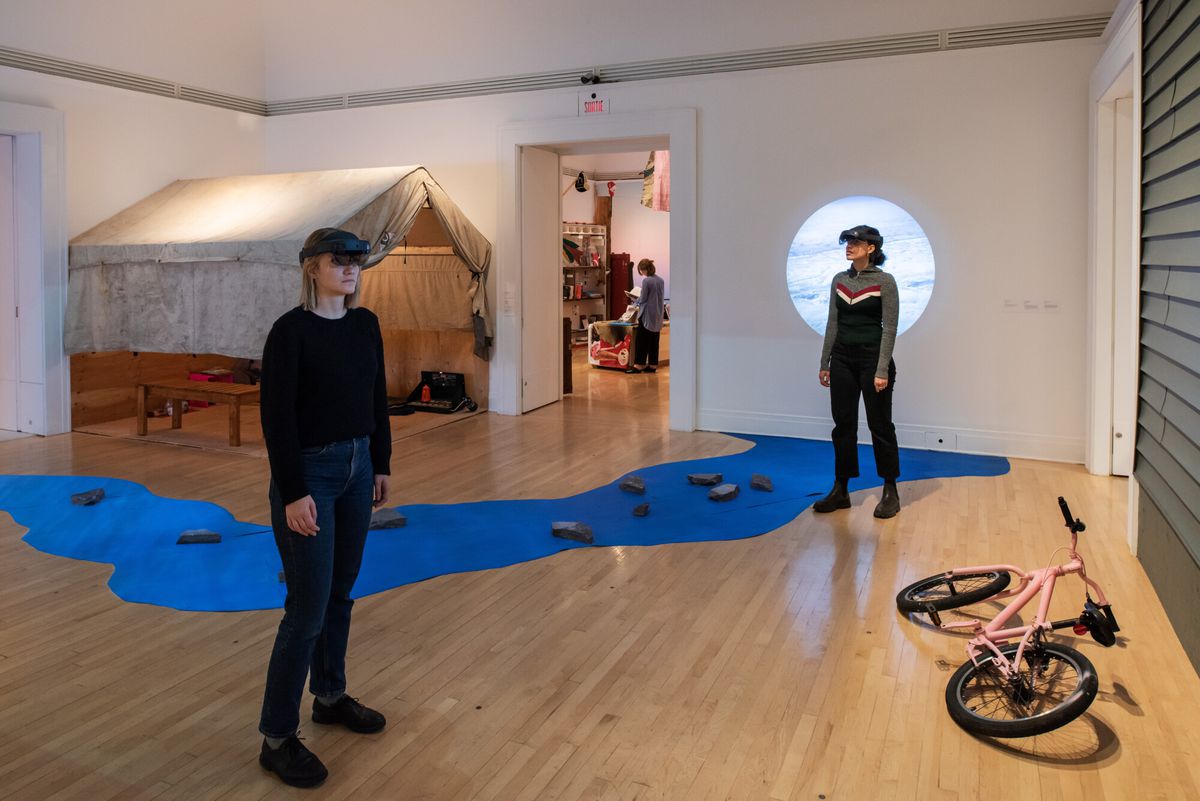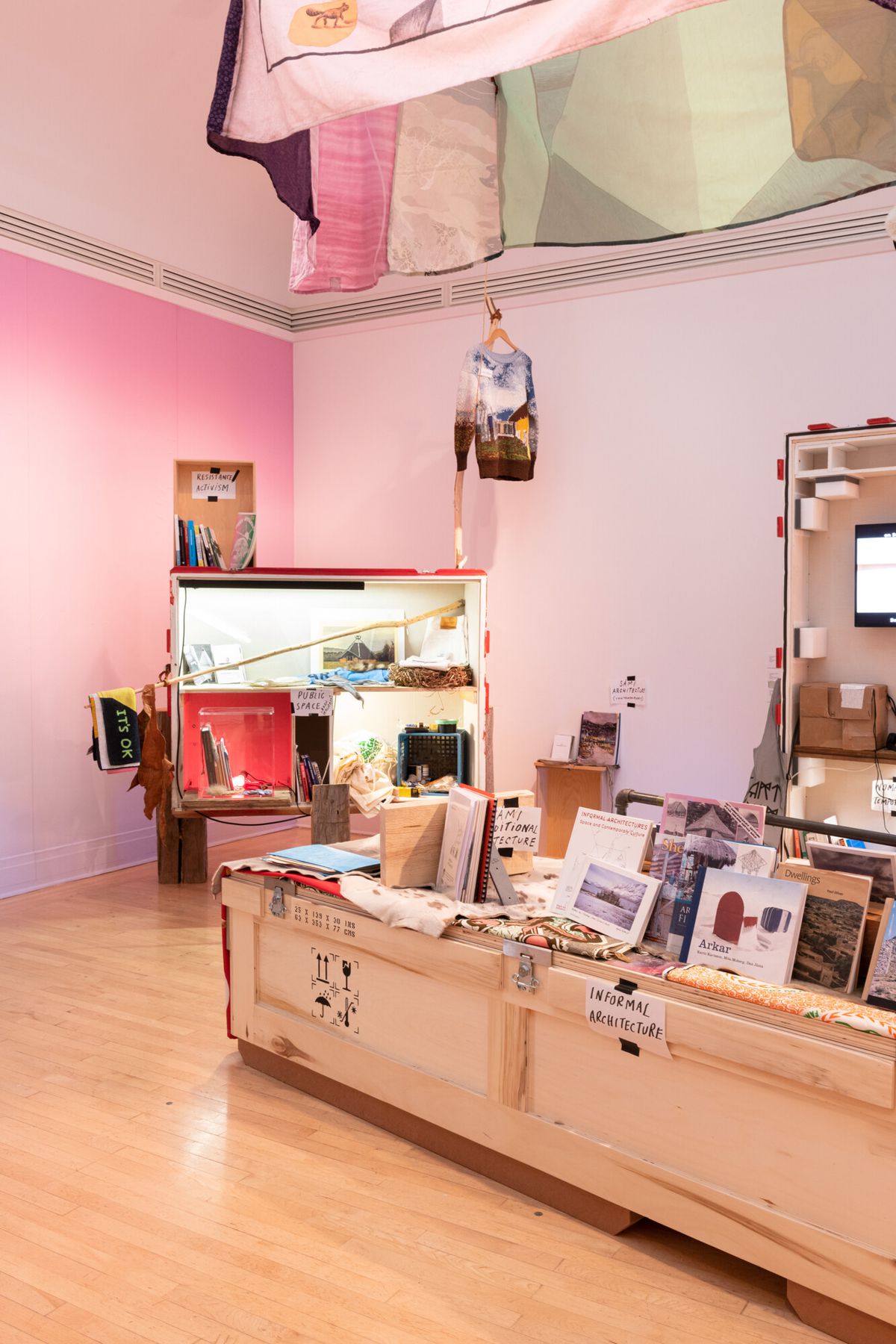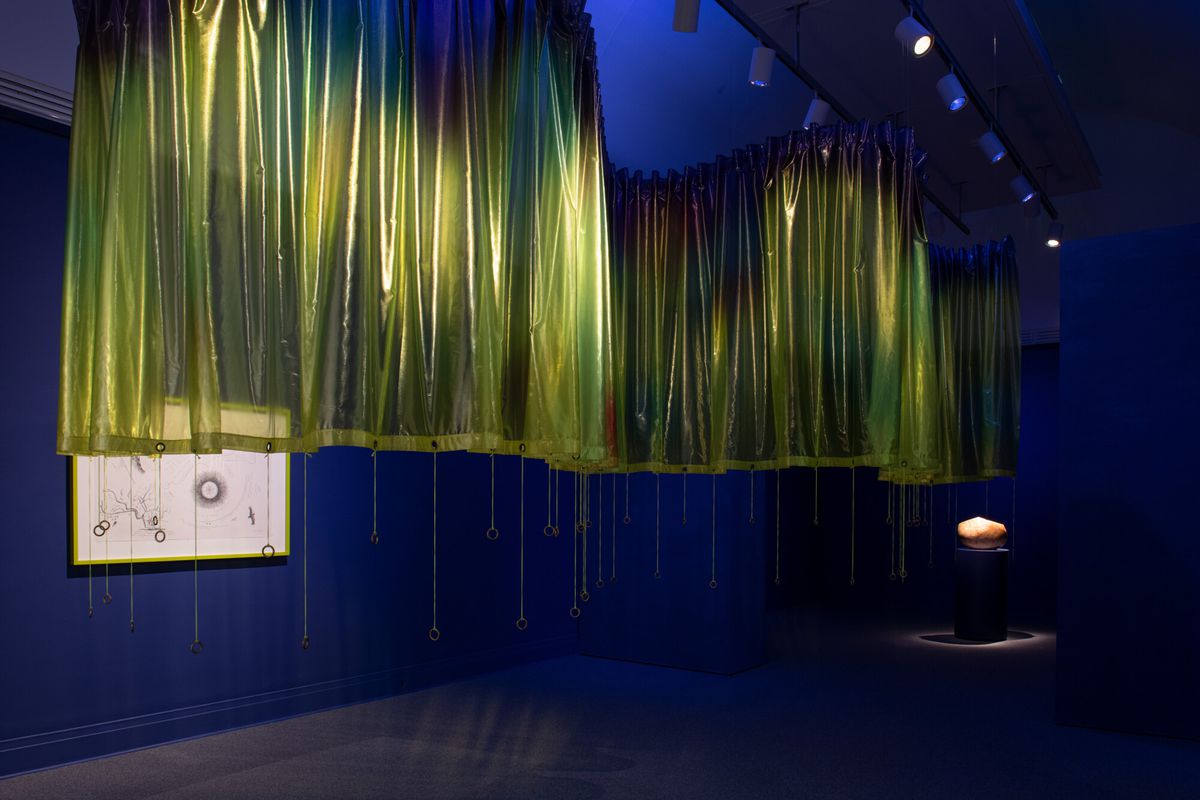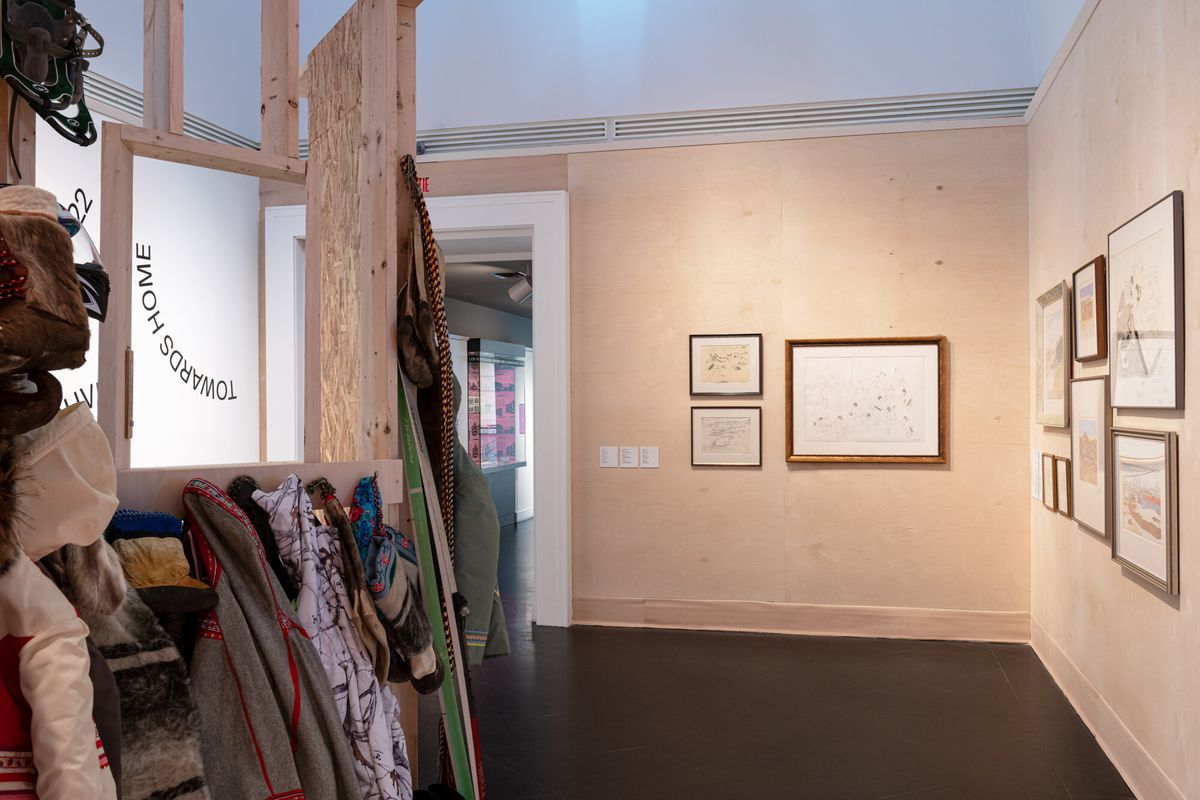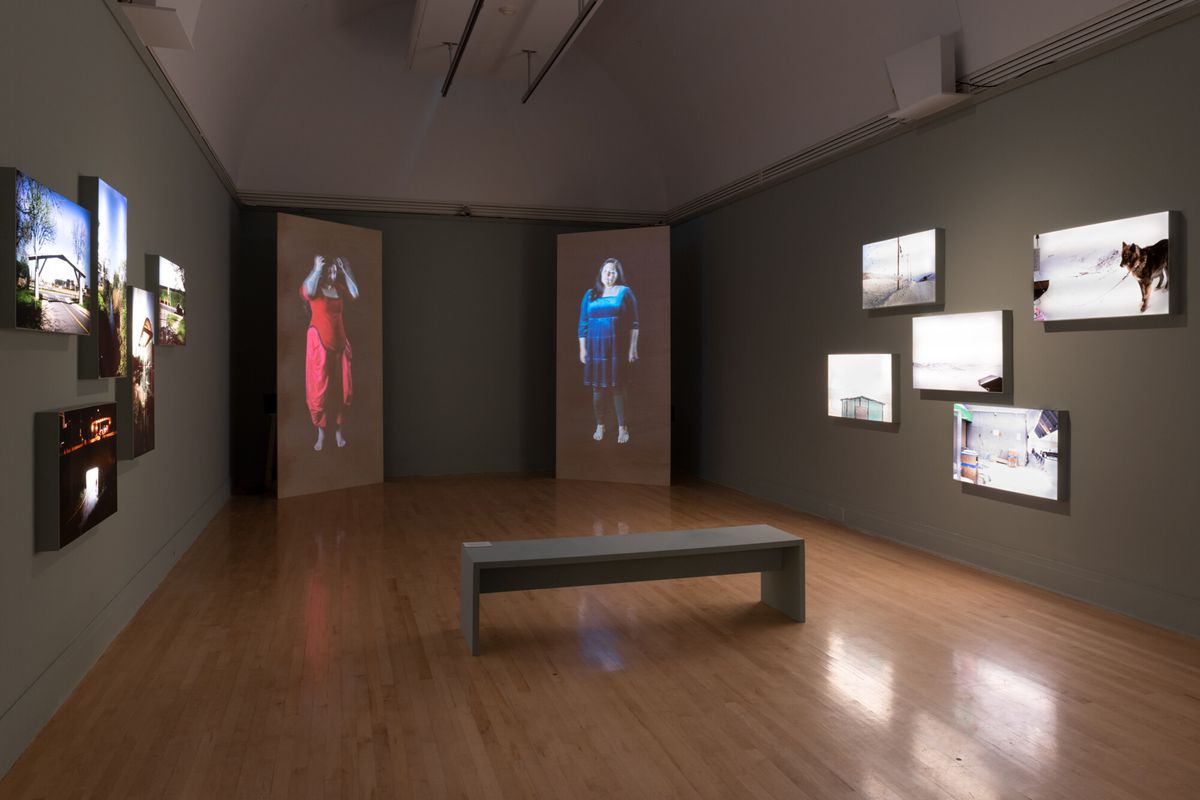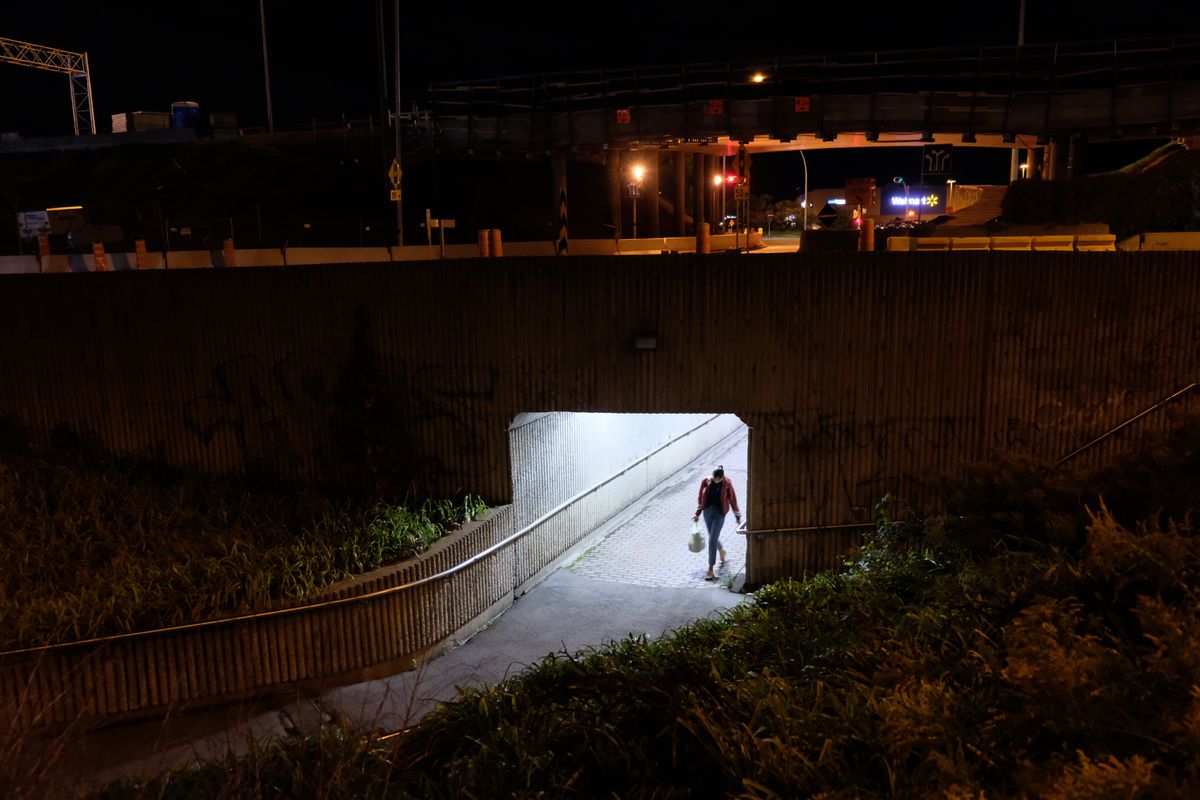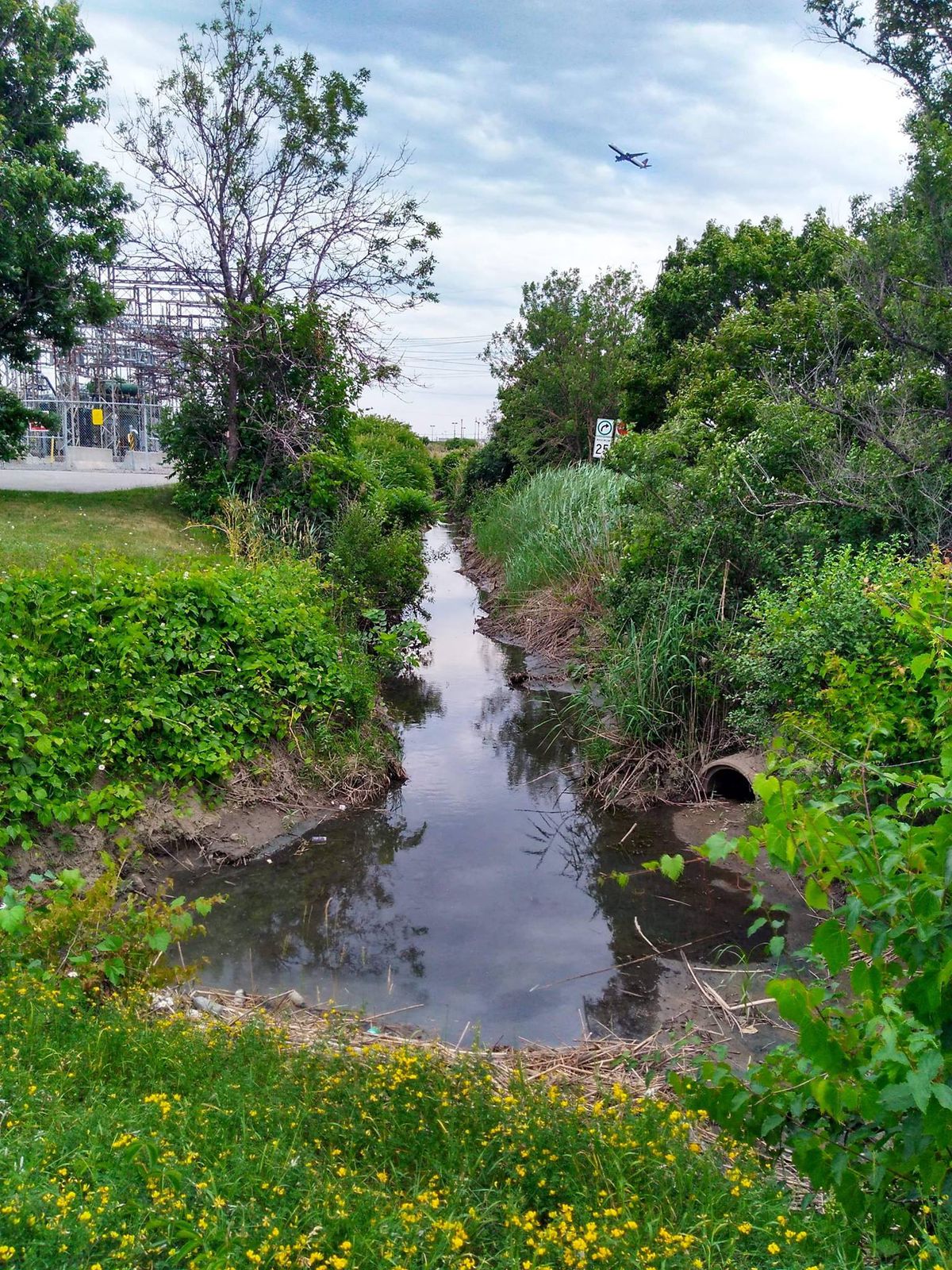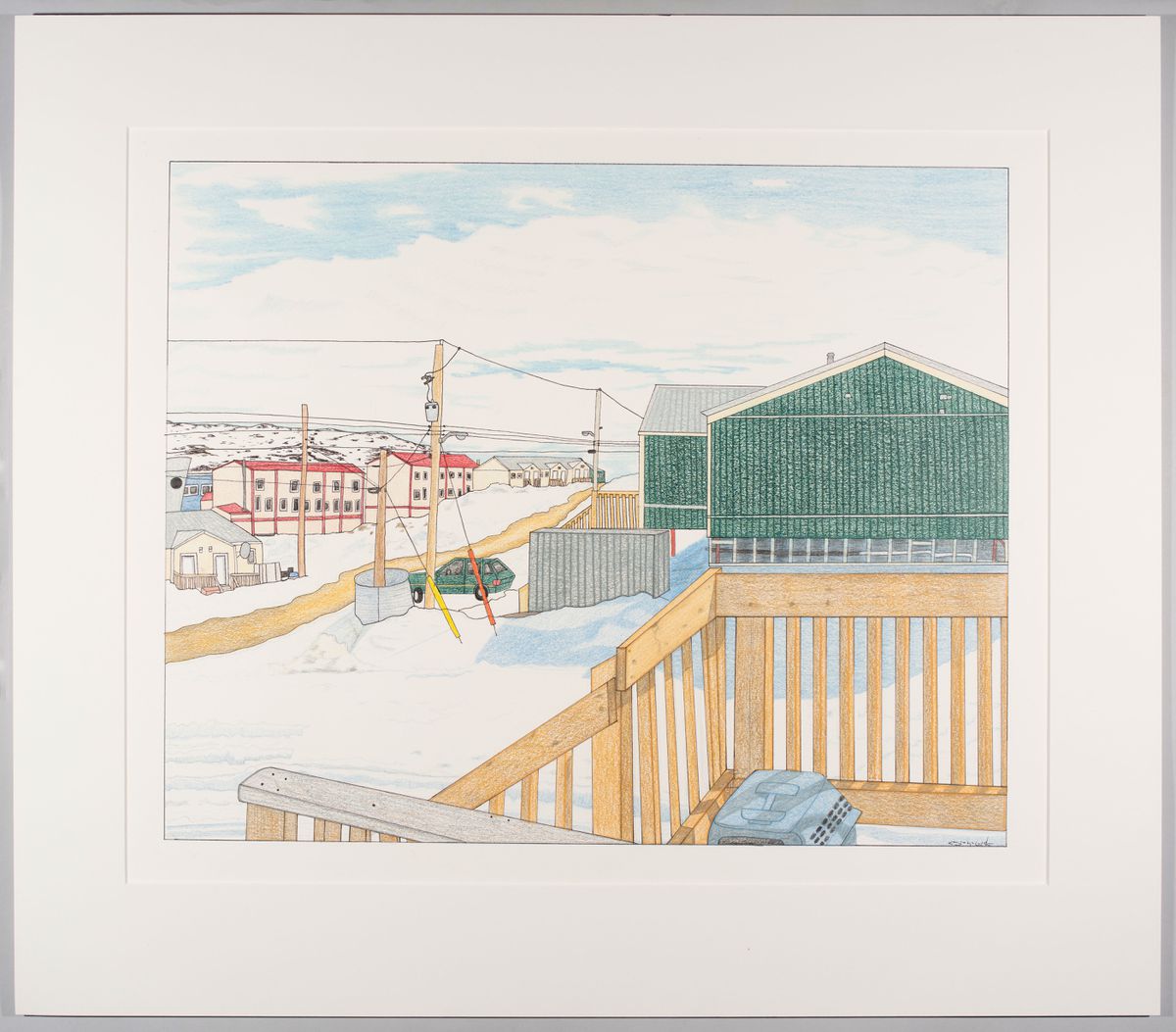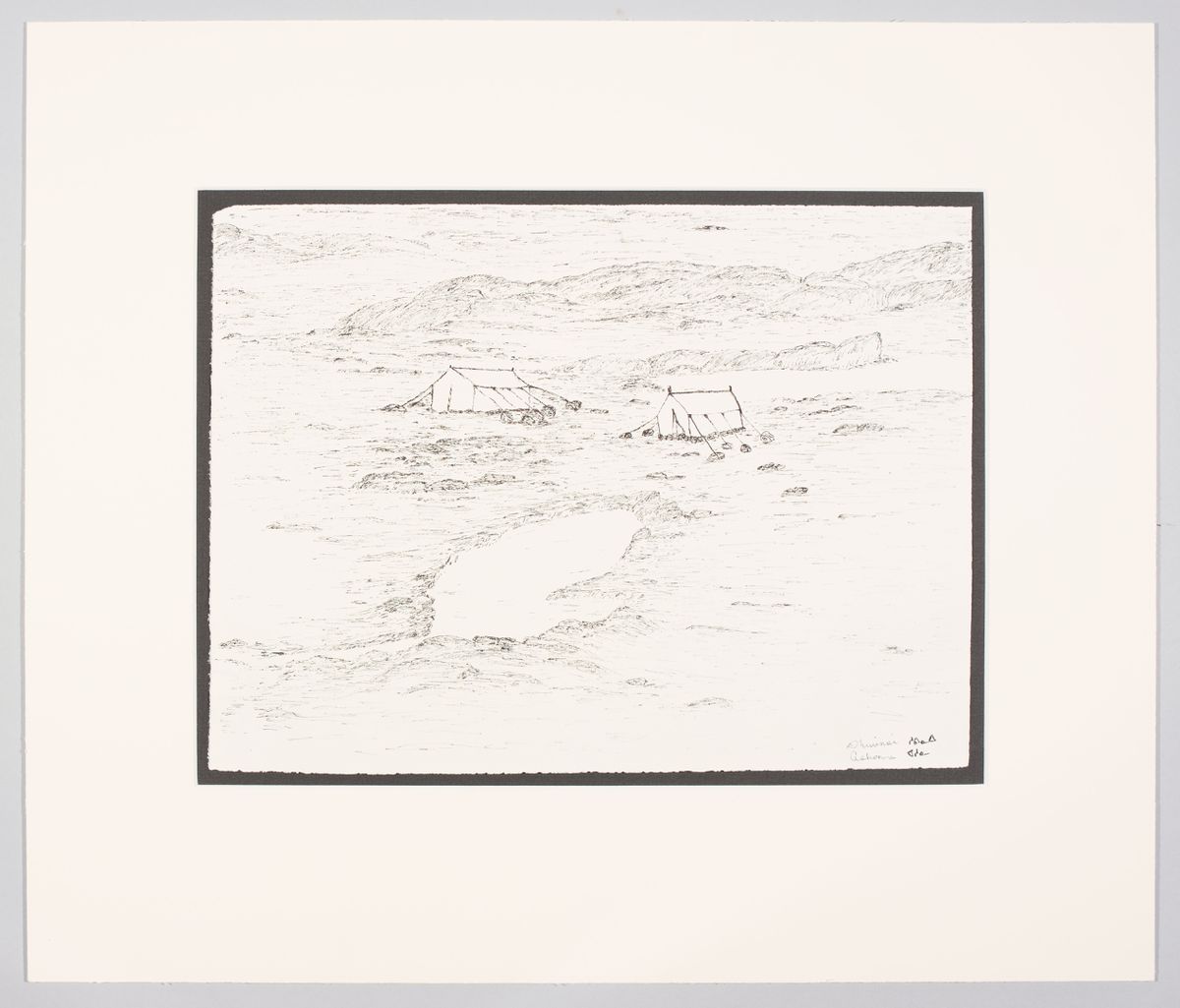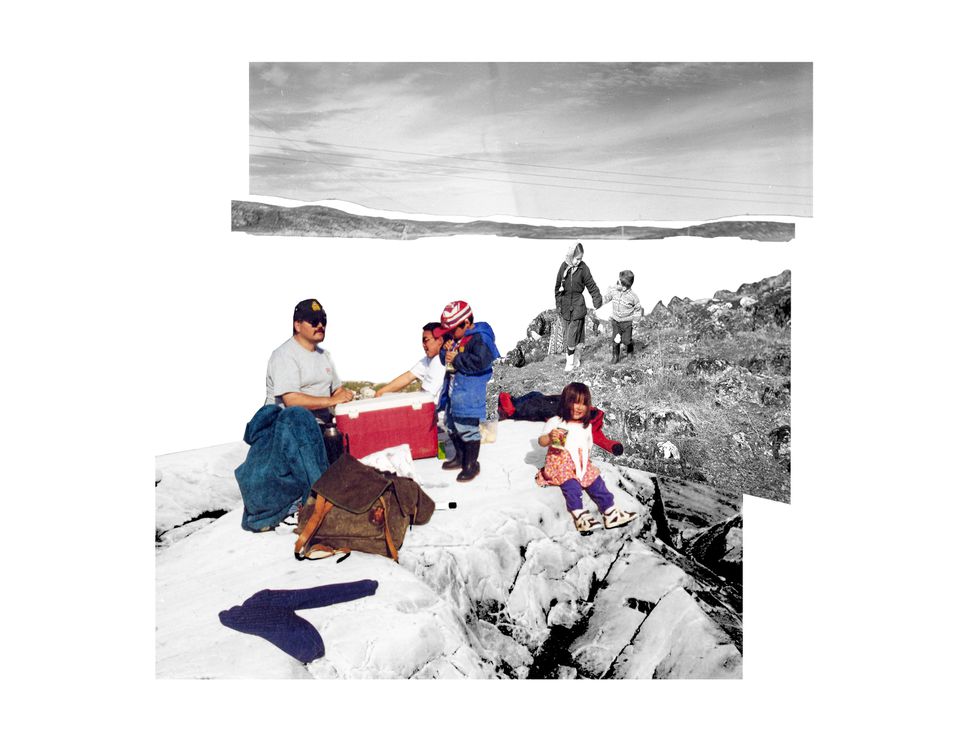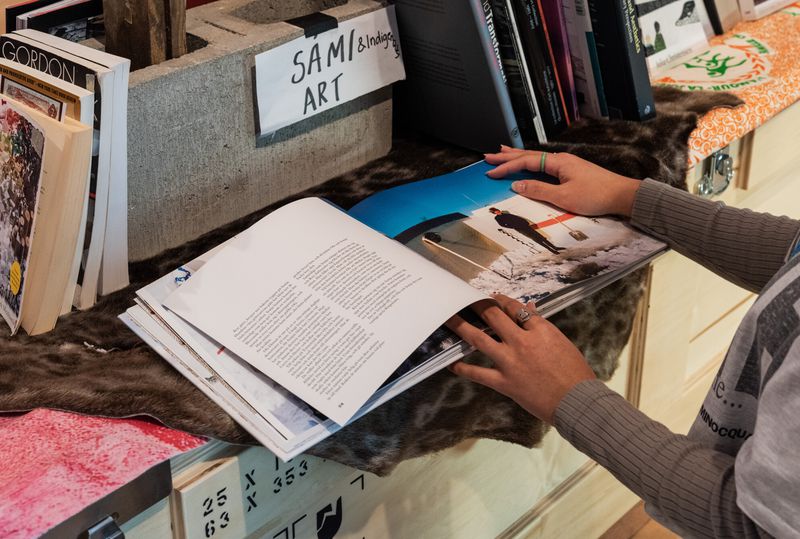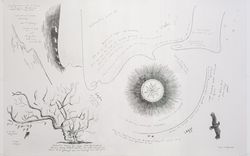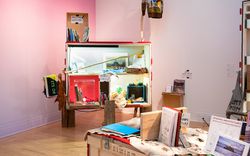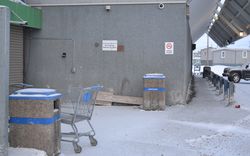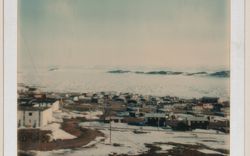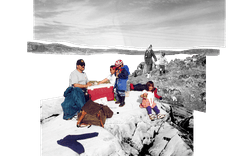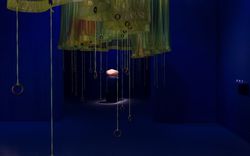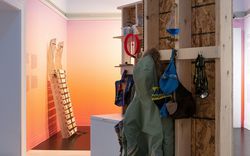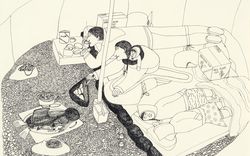ᔪᐊᕐ ᓇᓐᖑ, ᐃᓅᓚᐅᖅᓯᒪᔪᖅ 1979−ᖑᑎᓪᓗᒍ ᐋᓪᑕ, ᓄᕙᐃᒥᑦ, ᓵᒥᐅᔪᖅ ᐊᒻᒪᓗ ᓄᓇᖃᖅᑳᖅᓯᒪᓪᓗᓂ ᑎᑎᕋᐅᔭᖅᑎᐅᓪᓗᓂ ᐃᒡᓗᒃᓴᓂᒃ ᐊᒻᒪᓗ ᓴᓇᐅᒐᓕᐅᖅᑎᐅᒋᓪᓗᓂ ᓄᓇᖃᖅᖢᓂᓗ ᓄᕙᐃᒥᑦ. ᓇᓐᖒᑉ ᓴᓇᔭᖏᑦ ᖃᐅᔨᓴᕐᓂᐅᕗᑦ ᐃᓄᐃᑦ ᐃᖏᕐᕋᐃᓐᓇᐅᔭᖅᑐᑦ ᐱᐅᓯᖏᓐᓂᒃ ᐃᓂᖃᕐᕕᒃᓴᖏᓐᓂᒃ, ᐊᕕᒃᑐᖅᓯᒪᔪᓂᒡᓗ ᓄᓇᓕᒃᓴᖏᓐᓂᒃ, ᐊᒻᒪᓗ ᖃᓄᖅ ᖃᐅᔨᒪᑦᑎᐊᕈᑎᒃᓴᖏᓐᓂᒃ ᐊᖏᕐᕋᒥᒃ. ᑕᐅᑐᖕᓂᖃᒻᒪᕆᒃᐳᖅ ᐊᔾᔨᒌᖏᑦᑐᓂᒃ ᐱᔾᔪᑎᖃᖅᑐᓂᒃ ᖃᓄᖅ ᐱᖁᑎᖃᕋᔭᕐᓂᖏᓐᓂᒃ, ᐊᐅᓚᓂᖃᕐᓗᑎᒡᓗ ᐊᒻᒪᓗ ᐃᓂᒃᓴᖃᑦᑎᐊᕋᔭᕐᓂᖏᓐᓂᒃ.
Joar Nango, riegádan jagi 1979 Álttás, Norggas, lea sámi ja álgoálbmotarkiteakta ja dáiddár, gii ássá Norggas. Nango bargu guorahallá johtaleddjiid govahallamiid lanja, eanaguovlluid ja jurdagiid ruovttu hárrái. Son gidde fuopmášumi iešguđetlágan vugiide gieđahallat ávnnaslašvuođa, lihkadeami ja lanja.
Joar Nango, born 1979 in Alta, Norway, is a Sámi and Indigenous architect and artist living in Norway. Nango’s work investigates nomads’ conceptions of space, territory, and ideas of home. He focuses on different ways of dealing with materiality, movement, and space.
ᑕᕐᕋᓕᒃ ᐹᑦᑐᕆᑦᔾ ᓴᓇᐅᒐᓕᐅᖅᑎᐅᔪᖅ, ᑎᑎᕋᖅᑎᐅᓪᓗᓂᓗ, ᑕᑯᔭᒐᖃᕐᕕᓕᕆᔨᐅᓪᓗᓂᓗ, ᑰᔾᔪᐊᕐᒥᐅᑕᓪᓚᕆᕕᓂᖅ, ᓄᓇᕕᒃᒥᑦ, ᐊᒻᒪᓗ ᒫᓐᓇ ᐋᑐᕚᒥᐅᑕᐅᓕᖅᑐᖅ, ᑕᕝᕙᓂᓗ ᑐᑭᒧᐊᖅᑎᑦᑎᔨᐅᓪᓗᓂ ᓄᐊᕐᑎᒃ ᓛᑉᒥᑦ ᑕᕝᕙᓂ SAW Gallery−ᒥᑦ. ᑕᐅᑐᖕᓂᖃᓗᐊᖅᑐᖅ ᑖᕝᕙᓂ ᓄᐊᕐᑎᒃ ᓛᑉᒥᑦ ᖃᐃᖁᓯᔨᒪᓪᓗᓂ ᓴᓇᐅᒐᓕᐅᖅᑎᓕᒫᓂᒃ ᑕᒫᓂᕐᒥᐅᓂᑦ ᓯᓚᕐᔪᐊᑉ ᑲᓇᖕᓇᖓᓂᕐᒥᐅᓂᑦ ᐱᓕᕆᖃᑎᒌᖅᑯᓪᓗᓂᒋᓪᓗ ᐊᒻᒪᓗ ᓄᑖᓂᒡᓗ ᓴᓇᖁᓪᓗᓂᖏᑦ. ᑕᕐᕋᓕᒃ ᑕᑯᔭᒐᖃᕐᕕᓕᕆᔨᐅᖃᑕᐅᔪᖅ ᑕᕝᕙᓂ ᓴᓇᐅᒐᓕᕆᕕᒡᔪᐊᕐᒥᑦ Guelph−ᒥᑦ, ᓴᓇᓪᓗᓂᓗ ᐊᒥᓱᓂᒃ ᑕᑯᔭᒐᖃᕐᕕᓕᕆᔨᒃᑯᓐᓄᐊᖅᑕᐅᕙᒃᑐᓂᒃ ᐱᔾᔪᑎᖃᓗᐊᖅᑐᓂᒃ ᒪᑯᓂᖓ ᖃᐅᑕᒫᑦ ᐱᓕᕆᔾᔪᑕᐅᕙᒃᑐᓂᒃ. ᑕᕐᕋᓕᒃ ᐊᔾᔨᒌᖏᑦᑐᓂᒃ ᐱᓕᕆᓯᒪᓂᖓ ᑕᑯᔭᐅᓯᒪᒋᕗᑦ, ᓄᕕᖅᓴᖅᓯᒪᔪᓂᒃ ᓴᓇᔭᐅᓯᒪᔪᓂᒃ ᑲᓇᑕᓕᒫᒥᑦ ᐊᒻᒪᓗ ᑕᕆᐅᕐᔪᐊᑉ ᐊᑭᐊᓄᐊᕈᑎᕙᒃᖢᓂᒋᑦ, ᑕᑯᔭᐅᔪᓐᓇᕆᓪᓗᑎᒃ ᑕᕝᕙᓂ ᐅᕕᓐᔅ ᓴᓇᐅᒐᓕᕝᕕᒡᔪᐊᖓᓂᒃ (ᓵᒃᕕᐊᓪ, NB) ᐊᒻᒪᓗ ᒥᒧᓴ ᕼᐊᐅᔅᖓᓂᑦ (ᓚᓐᑕᓐ, UK) ᑕᕝᕙᓂ 2022−ᖑᓕᖅᐸᑦ.
Taqralik Partridge lea dáiddár, girječálli ja kuráhtor, gii boahtá Kuujjuaqis, Nunavikas, ja gii dál orru Ottawas, gos son lea Saw Gallery Nordic Lab hoavda. Nordic Lab:s son gidde fuopmášumi čohkket dáiddáriid cirkumpolára máilmmis bargat ovttas ja duddjot ođđa bargguid. Taqralik bargá maiddái veahkkekuráhtorin Art Gallery of Guelph:s, gos bargá máŋggain čájáhusain fáttás Qautamaat/Everyday/Árgabeaivi. Taqralik:a seahkálasmedia tekstiilabarggut leat johtán Kanadas ja ábi nuppi bealde, ja čájehuvvojit Owens Art Gallery:s (Sackville, New Brunswick) ja Mimosa House:s (London, Stuorra-Británnia) jagi 2022.
Taqralik Partridge is an artist, writer, and curator, originally from Kuujjuaq, Nunavik, and now based in Ottawa, where she is director of the Nordic Lab at SAW Gallery. Her focus at the Nordic Lab is on bringing together artists from across the circumpolar world to collaborate and create new work. Taqralik is also an adjunct curator at the Art Gallery of Guelph, where she is working on a series of exhibitions on the theme of Qautamaat/Everyday. Taqralik’s mixed-media textile works have toured Canada and overseas and can be seen at the Owens Art Gallery (Sackville, NB) and at Mimosa House (London, UK) in 2022.
ᔮᔅᓕᓐ ᐲᕋᐃᓂᓐ, ᖃᓪᓗᓈᑦ ᓄᓇᖓᓂᕐᒥᐅᑕᐅᓪᓗᓂ ᐃᓄᒃ, ᐃᖃᓗᒃᑑᑦᑎᐊᕐᒥᐅᑕᓪᓗᓂ, ᓄᓇᕗᒻᒥᑦ. 2019−ᖑᑎᓪᓗᒍ ᐱᓕᕆᖃᑦᑕᖅᓯᒪᓂᑰᔪᖅ ᑕᑯᔭᒐᖃᕐᕕᓕᕆᓂᐅᓂᕐᒧᑦ ᐃᓄᐃᑦ ᓴᓇᐅᒐᓕᕆᓂᕐᒧᑦ ᑕᑯᔭᒐᖃᓂᕐᕕᐊᓂᑦ ᕗᐃᓂᐸᐃ ᓴᓇᐅᒐᖃᓕᕆᕝᕕᐊᓂᑦ ᐊᒻᒪᓗ ᖃᐅᒪᔪᕐᒥᑦ. ᐃᓕᓐᓂᐊᖅᑕᒥᓂᒃ ᐃᓱᓕᑦᑎᓚᐅᖅᓯᒪᔪᖅ ᑳᓪᑕᓐ ᓯᓚᑦᑐᖅᓴᕐᕕᒡᔪᐊᖓᓂᑦ, ᐱᕋᐃᓂᓐ ᐃᓕᓐᓂᐊᓚᐅᖅᓯᒪᔪᖅ ᓴᓇᐅᒐᓕᕆᓂᕐᒥᒃ, ᐱᓗᐊᖅᑐᒥᒃ ᑕᕐᕆᔮᒃᓴᓕᐅᕐᓂᕐᒥᒃ ᐊᒻᒪᓗ ᓄᑖᓂᒃ ᑐᓴᒐᒃᓴᓕᕆᓂᕐᒧᑦ. ᑕᑯᔭᒐᖃᕐᕕᓕᕆᓂᕐᒥᒃ ᓴᓇᔪᓐᓃᕌᖓᑦ, ᓴᓇᖃᑦᑕᖅᑐᖅ ᐊᓇᓗᒡ ᐊᔾᔨᓕᐅᕆᔨᓂᒃ ᐊᒻᒪᓗ ᐊᔾᔨᓕᐅᕆᕙᒃᖢᓂ ᓴᓇᐅᒐᓕᐅᖅᑕᒥᓂᒃ − ᖃᐅᔨᒃᑲᓐᓂᕋᓱᒃᖢᓂ ᑕᒪᒃᑯᓂᖓ ᐊᔾᔨᑖᒃᑲᐅᑎᒋᓲᓂᒃ ᐊᒻᒪᓗ Super 8 ᐊᔾᔨᓕᐅᕈᑎᓂᒃ − ᐊᒻᒪᓗ ᓂᒃᓯᒃᑕᖅᐸᒃᖢᓂ ᐊᒻᒪᓗ ᓱᖓᐅᔭᓕᕆᕙᒃᖢᓂᓗ. ᑐᓂᓯᓯᒪᖕᒥᔪᖅ ᑎᑎᕋᖅᑎᐅᔪᓄᑦ ᒪᑯᓂᖓ, ᑲᓇᑕᒥ ᓴᓇᐅᒐᓕᕆᓂᖅ, ᑲᓇᑕᒥ ᓄᓇᓕᕆᓂᖅ ᐊᒻᒪᓗ ᐃᓄᐃᑦ ᓴᓇᐅᒐᓕᕆᔨᑦ ᓴᓇᔭᖏᓐᓂᒃ ᑕᖅᑭᑦ ᑎᓴᒪᑦ ᐊᓂᒍᖅᓯᒪᓕᕌᖓᑕ ᐱᔭᐅᓲᓂᒃ.
Jocelyn Piirainen lea gávpotinuhkka, gii boahtá Iqaluktuuttiaqis, Nunavutas. Jagi 2019 rájes son lea bargan inuihta dáidaga nubbekuráhtorin Winnipeg Art Gallery:s ja Qaumajuqis. Carleton University:s Piirainen logai vuosttažettiin dáidaga, earenoamážit filmma ja ođđa mediaid. Go son ii leat bargamin kuráhtorin, son buđalda analoga fotografiijain ja filmmain dáiddalaš geavadisttis – eanaš son geahččaladdá Polaroid ja Super 8 filmmain – ja vátná heahkkalastin- ja helbmodáidduidis. Son lea čállán publikašuvnnaide nugo Canadian Art, Canadian Geographic ja Inuit Art Quarterly.
Jocelyn Piirainen is an urban Inuk, originally from Iqaluktuuttiaq, Nunavut. Since 2019, she has been working as the Associate Curator of Inuit Art at the Winnipeg Art Gallery and Qaumajuq. A graduate of Carleton University, Piirainen was educated primarily in the arts, particularly in film and new media. When not working as a curator, she works with analog photography and film in her artistic practice—mostly experimenting with Polaroids and Super 8 film—and hones her crochet and beading skills. She has contributed to publications such as Canadian Art, Canadian Geographic, and the Inuit Art Quarterly.
ᕋᕕᑯ ᕈᐃᔅ ᓄᓇᖃᖅᑐᖅ (ᐅᐃᓕᓂᖅᐸᓯᐊᓂᑦ ᐋᓐᑎᐊᕆᔭᐅᑉ/Ecuador) ᖃᐅᔨᓴᖅᑎᐅᓪᓗᓂᓗ ᐊᒻᒪᓗ ᑕᑯᔭᒐᖃᕐᕕᖕᒥ ᓴᓇᔨᐅᓪᓗᓂ. ᓴᓇᔭᖏᑦ ᐱᔾᔪᑎᖃᖅᐳᑦ ᐃᒡᓗᖁᑎᒋᔭᐅᔪᓂᒃ ᐅᑭᐅᖅᑕᖅᑐᒥᑦ, ᓯᕗᓂᐊᓂᒡᓗ ᓄᓇᕐᔪᐊᖅ ᐅᖅᑯᓯᕙᓪᓕᐊᓂᖓᓂᒃ ᓯᑯᓂᒃ, ᐊᒻᒪᓗ ᖃᐅᔨᓇᓱᒃᐸᒃᖢᓂ ᓄᓇᑦᑖᖅᓯᒪᔪᑦ ᖃᓄᖅ ᐱᔪᓐᓇᕋᔭᕐᓂᖏᓐᓂᒃ. ᕈᐃᔅ ᑎᑎᕋᖅᓯᒪᔪᖅ ᐆᒥᖓ ᓱᒃᑲᐃᑦᑐᒥᒃ ᐅᓚᕕᓴᐃᓂᐅᔪᒥᒃ: ᐊᖏᖃᑎᒌᒃᑎᑦᑎᓇᓱᖕᓂᕐᒥᒡᓗ ᐱᔾᔪᑎᖃᓗᐊᖅᑐᒥᒃ ᓄᓇᖃᓕᓴᖅᑐᓄᑦ ᐱᒋᔭᐅᔪᓂᒃ, ᐊᒻᒪᓗ ᑎᑎᕋᖅᑎᐅᖃᑕᐅᒋᓪᓗᓂ ᑖᔅᓱᒥᖓ (ᒥᓗᑎ ᔪᐃᒥᒃ) Saturation-ᒥᐅᑕᖅ: ᑎᑎᕋᖅᖢᑎᒡᓗ ᐆᒥᖓ ᒐᕙᒪᓕᕆᓂᖅ, ᑕᒪᕐᒥᒃ ᑎᑎᕋᖅᑕᐅᒻᒪᕆᓚᐅᖅᓯᒪᔪᑦ ᐆᒧᖓ ᑑᒃ ᓯᓚᑦᑐᖅᓴᕐᕕᒡᔪᐊᖓᓄᑦ ᑎᑎᕋᕐᕕᐅᔪᒥᑦ. ᑐᑭᒧᐊᖅᑎᑦᑎᔨᐅᖃᐅᒋᓪᓗᓂ ᖃᐅᔨᓴᕐᓂᕐᒧᑦ ᑕᕝᕙᓂ CCA−ᒥᑦ.
Rafico Ruiz lea ođđaássi (Orjješdavvi Ontario/Ecuadora) dutki ja kuráhtor. Su barggut gieđahallet infrastruktuvrra huksema Árktisa, postglobála jieŋa suddama ja ođđaássiid vásttolašvuođa geavadiid. Ruiz lea gieskadaš čállán Slow Disturbance: Infrastructural Mediation on the Settler Colonial Resource Frontier, ja lea ovttas (Melody Jue:in) doaimmahan Saturation: An Elemental Politics, maid goappašagaid lea Duke University Press almmuhan. Son lea maid CCA dutkama nubbehoavda.
Rafico Ruiz is a settler (Northwestern Ontario/Ecuador) researcher and curator. His work addresses infrastructure building in the Arctic, post–global warming ice, and practices of settler accountability. Ruiz is the author most recently of Slow Disturbance: Infrastructural Mediation on the Settler Colonial Resource Frontier, and the co-editor (with Melody Jue) of Saturation: An Elemental Politics, both published by Duke University Press. He is also the Associate Director of Research at the CCA.
